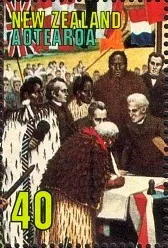For an index to all our posts concerning The Maori People.
 I have just completed a series of posts on the six heritage issues leading up to the celebrating of 150 years since the signing of the Treaty of Waitangi so I thought I should include the stamp issue on the anniversary itself. My purpose here is not to go into great detail on the history and debate surrounding this treaty, but rather just celebrate it as the founding document of the nation of New Zealand.
I have just completed a series of posts on the six heritage issues leading up to the celebrating of 150 years since the signing of the Treaty of Waitangi so I thought I should include the stamp issue on the anniversary itself. My purpose here is not to go into great detail on the history and debate surrounding this treaty, but rather just celebrate it as the founding document of the nation of New Zealand.The Treaty of Waitangi (Māori: Tiriti o Waitangi) is a treaty first signed on 6 February 1840 by representatives of the British Crown and various Māori chiefs from the North Island of New Zealand.
The Treaty established a British Governor of New Zealand, recognised Māori ownership of their lands and other properties, and gave the Māori the rights of British subjects. The English and Māori versions of the Treaty differed significantly, so there is no consensus as to exactly what was agreed to. From the British point of view, the Treaty gave Britain sovereignty over New Zealand, and gave the Governor the right to govern the country. Māori believed they ceded to the Crown a right of governance in return for protection, without giving up their authority to manage their own affairs.
After the initial signing at Waitangi, copies of the Treaty were taken around New Zealand and over the following months many other chiefs signed. In total there are nine copies of the Treaty of Waitangi including the original signed on 6 February 1840. Around 530 to 540 chiefs, at least 13 of them women, signed the Treaty of Waitangi.
1990 - Treaty of Waitangi 150th Anniversary.
40c - Lieutenant Governor William Hobson greeting Maori Leader.
40c - Signing of The Treaty of Waitangi,
Both of these stamps were only issued as part of the miniature sheet below. They were never issued separately therefore are usually found still part of the sheet.
The sheet was designed by A G Mitchell, of Wellington, using an original water colour painting by his father, Len Mitchell.
Some of the images in this post were used with permission from the illustrated catalogue of StampsNZ
You can visit their web site and On-line Catalogue at, http://stampsnz.com/


We appreciate your engagement with our content. To ensure a respectful and constructive community, please take note of the following:
- No Spam, Please: We do not tolerate spammy or promotional comments. Any such comments will be promptly removed.
- Moderation in Place: All comments are moderated to maintain a positive and inclusive environment. Please be patient, as it may take a little time for your comment to appear.
- Sign In with Google: To comment, please sign in using your Google account. This helps us maintain the integrity of our community and allows for better interaction.